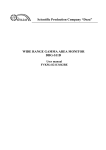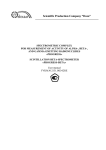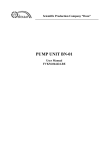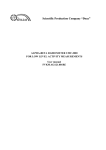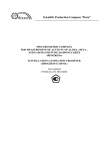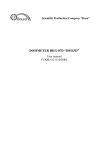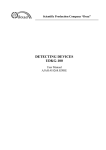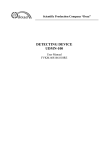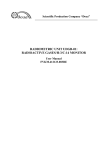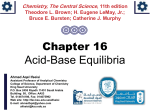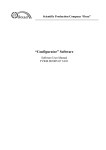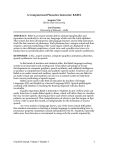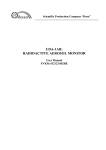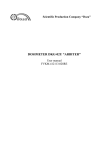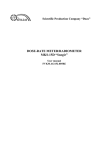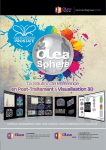Download User Manual
Transcript
Scientific Production Company “Doza” GAS RADIOMETER UDG-03D User manual FVKM.412123.011RE Cont ent 1 Description and operation of the product ……………………………………… 1.1 Product functionality ……………………………………….……………… 1.2 Technical characteristics ……………………………………………..…….. 1.3 Configuration ………………………………………………………….…… 1.4 Design and operation ………..…………………………………….……….. 1.5 Marking and sealing …………………………………………………...…… 1.6 Packing ………………………………………………………...…………… 2 Intended use ……………………………………………………………………. 2.1 Operational limitations ……………………………………….……..……… 2.2 Preparation of the product for use ..……..……………………...………...… 2.3 Use of the product ..………….……………………………….……..……… 2.4 Adjustment ………………………………….……………………………… 3 Maintenance ……………………………………………..…………………...… 3.1 General notes ………………………………………………..………...…… 3.2 Safety precautions …………………………………………….………….… 3.3 Maintenance routine …………………………………………………….….. 4 Calibration routine ……………….…………………………………..………… 4.1 General requirements …………………………………….………………… 4.2 Preliminary arrangements ………………………………………...…...…… 4.3 Safety precautions ………………………………………………………..… 4.4 Conditions …...……………………..…………………………………...….. 4.5 Procedure ……………………………………………………….……..…… 5 Routine repairs ……………………………………………………………….… 6 Storage ……………………………………………………………………….… 7 Transportation ………………………………………………………………….. 8 Disposal ……………………………………………………………………...… 3 3 3 5 5 6 6 6 6 6 10 10 10 10 10 11 14 14 14 15 15 15 17 17 18 18 Appendix A Description of data exchange registers in the DiBUS protocol ….…… Appendix B Outline drawing …………………………………………………..…… Appendix C Wiring diagram …………………………………………………...…… Appendix D Connection layout ……………………………………..……………… Appendix E “DWPTest” software user manual …………………………….……… 19 20 21 22 25 FVKM.412123.011RE 2 This User Manual contains information on design, principle of operation, characteristics of the product and instructions essential for correct and safe use of this product (intended use, maintenance, servicing, storage and transportation), as well as information regarding the utilization of the product. 1 DESCRIPTION AND OPERATION OF THE PRODUCT 1.1 Product functionality Gas radiometer UDG-03D FVKM.412123.011 (hereinafter – radiometer) are designed for continuous measurements of activity concentration of beta radioactive gases (argon, krypton, xenon) in monitored areas at nuclear power and nuclear industry facilities, on ships with nuclear power plants as part of the radiation monitoring systems, complexes and installations. Radiometer is capable to transfer to an external data transmission channel the following: measured value, estimate of statistical uncertainty of measured value and self-testing information according to DiBUS protocol using RS-485 interface. Radiometer is permanently mounted on load-bearing structure using a bracket. Radiometers are available in two modifications different by features as shown in Table 1.1. Table 1.1 – Modifications of radiometers Designation of modification Modification FVKM.412123.011 Basic modification FVKM.412123.011-01 Modification 01 Design features One chamber is used for measuring of activity concentration of radioactive gases, another one is used for measuring of background radiation Both chambers are used for measuring of activity concentration of radioactive gases to increase the sensitivity of the radiometer 1.2 Technical characteristics 1.2.1 Energy range of measured beta radiation ………………...……………… 60 to 3000 keV. 1.2.2 Measurement range of activity concentration of beta radioactive gases …………………………………………….……… 1.0·104 to 1.0·1010 Bq/m3. 1.2.3 Limits of the permissible basic relative error for measurements of activity concentration of beta radioactive gases ……………………………………………… 20 %. 1.2.4 Sensitivity of radiometer to beta radiation: - 90Sr (90Y) (point source) …………………………..…… 1.7·10-4 to 8.5·10-4 particlem3/Bqs; - 85Kr ………………………………………………….…………… 1·10-6 to 5·10-6 cpsm3/Bq. Not e - Sensitivity to beta radiation of 85Kr was obtained by experimental method and is intended for reference. 1.2.5 Warm-up time ……………………………………...……………… not more than 10 min. 1.2.6 Continuous operation …………………………….….………………… not less than 24 h. 1.2.7 Instability of readings during 24 hours of continuous operation relative to the mean value of the first measurement readings ……………………………………….….…… not more than 10 %. 1.2.8 Intrinsic background of radiometer ………………………..… not more than 4·103 Bq/m3. 1.2.9 Air flow rate ……………………………………………………… not less than 10 L/min. 1.2.10 Radiometer is capable to transfer to an external data transmission channel the following: measured value, estimate of statistical uncertainty of measured value and self-testing information according to DiBUS protocol using RS-485 interface. Description of data exchange registers using DiBUS protocol is given in Appendix A. FVKM.412123.011RE 3 1.2.11 Power supply of radiometer is provided from a DC source with voltage 12 63 V. 1.2.12 Power consumption …………………………………...…………… not more than 5 VA. 1.2.13 Operating conditions: - operating temperature range …………………………….………… from minus 10 to +50 °C; - limiting value of relative humidity ………………………..………………… 98 % at +35 C; - atmospheric pressure ……………………………………………………… 84.0 to 106.7 kPa; - allowable content of corrosive agents in the ambient air are presented in Table 1.2. Table 1.2 Type of atmosphere Designation Type I Relatively clean II Industrial III Marine Content of corrosive agents Sulfur dioxide gas not more than 20 mg/(m2·day) (not more than 0.025 mg/m3); Chlorides not more than 0.3 mg/(m2·day) Sulfur dioxide gas not more than 20 to 250 mg/(m2 ·day) (not more than 0.025 to 0.31 mg/m3); Chlorides not more than 0.3 mg/(m2·day) Sulfur dioxide gas not more than 20 mg/(m2·day) (not more than 0.025 mg/m3); Chlorides 30 to 300 mg/(m2·day) 1.2.14 Limits of the permissible complementary error of measurements of activity concentration of beta radioactive gases: - due to ambient air temperature deviation from normal conditions to operating limits ±10 %; - due to increased humidity of ambient air equal to 98 % at +35 C ……………………±10 %. 1.2.15 Radiometer are resistant to sinusoidal vibrations in the frequency range 10 to 55 Hz with displacement amplitude of 0.35 mm. Limits of the permissible complementary error of measurements of activity concentration of beta radioactive gases under the impact of vibration ……………………………………..……… 5 %. 1.2.16 Radiometer is stable against seismic impacts with magnitude 7 according to the MSK-64 scale, being installed on the building structures of the industrial site at 70 to 30 m relative to the grade level. During seismic impact and after it radiometer can perform its functions and maintains operability according to 1.2.3, 1.2.9. 1.2.17 Degree of protection provided by casings of radiometer against ingress of solid items and water …………………………………………………………………………… IP65. 1.2.18 Radiometer is stable against electromagnetic interference in compliance with IEC 10004-8-93, IEC 1000-4-9-93, IEC 61000-4-2:2008, IEC 61000-4-3:2006, IEC 61000-4-4:2004, IEC 61000-4-5-95, IEC 61000-4-6-96, IEC 61000-4-12-95 and complies with the emission standards stated by IEC 22:2006 for class A equipment. 1.2.19 Radiometer is resistant to the effects of background gamma radiation with maximum level of ambient dose equivalent rate 0.01 mSv·h-1, under these conditions the complementary measurement error of activity concentration of beta radioactive gases will not exceed ……..… 20 %. 1.2.20 Degree of protection against electric shock of radiometer complies with the requirements of IEC 61010-1:2001. 1.2.21 Radiometer is a fire-safe product with probability of causing fire less than 10-6 year-1. 1.2.22 Radiometer withstands the exposure to decontaminating solutions: 1) caustic soda (NaOH) – 50 g/l, potassium permanganate (KMnO4) – 5 g/l; FVKM.412123.011RE 4 2) oxalic acid (H2C2O4) – 10 - 30 g/l, nitric acid (HNO3) – 10 g/l; 3) 5 % citric acid solution in rectified alcohol C2H5OH (ethanol concentration 96 %). 1.2.23 Overall dimensions of radiometer ……………….………………… (474246243) mm. 1.2.24 Weight of radiometer ………………………………….………………………… 29.5 kg. 1.2.25 Mean time to failure of radiometer ……………………………… not less than 20 000 h. 1.2.26 Mean life time of radiometer …………………………………… not less than 10 years, subject to the replacement of worn out blocks. 1.3 Configuration 1.3.1 Radiometer is functionally and structurally complete device. The following is included in the radiometer delivery kit: - check source in a holder intended to test the radiometer; check source is stored in a separate box; - filter holder supplied on request; the holder is used for placing an AFA filter to prevent the ingress of dust and aerosols in the working volume of the chamber; - for measurements of activity concentration of gas mixtures containing radioactive isotopes of iodine additional treatment of gas mixture is needed using filters – absorbers of iodine; - “DWPTest” software to be used to control the radiometer, and to setup and calibrate it via PC, if necessary; - installation kit for connection to the sampling systems and RS-485 network. 1.4 Design and operation 1.4.1 Radiometer is equipped with two identical measuring chambers with semiconductor detectors. The chambers can be connected in parallel (modification 01) to increase the radiometer sensitivity; alternatively, one chamber may be connected to gas main line while another chamber is silenced and is used to measure the ambient background radiation at the radiometer location (basic modification) – the latter connection is preferable if the radiation background is unstable. When pumping air through the chambers the air passes through the inlet aerosol filter on which aerosol particles are deposited, then it enters the chambers through flow indicator. Each chamber has a semiconductor detector with preamplifier. Beta particles emitted by nuclei of radioactive gases generate electrical pulses when they pass through a detector. The pulses from the preamplifier are fed to the inputs of two-input shaper. Outline drawing and wiring diagram are presented in Appendix B and Appendix C, accordingly. 1.4.2 To compensate the external background, the radiometer in its basic modification uses one of the chambers for measurements of activity concentration of radioactive gases, while a silenced chamber is used for measurements of background radiation. In the calculations of activity concentration, readings of the chamber used for measurements of background radiation are subtracted from detector readings in the working chamber. In the “modification 01”, where radiometer sensitivity is the priority, both chambers are used for measurements of activity concentration of radioactive gases, and the value measured by the radiometer during at least 2000 seconds without air pumping is used as the background value. In this case for the calculation of activity concentration readings of two chambers are averaged. When the flow rate falls below acceptable level, a message is generated that there is no air pumping; this message is not a radiometer failure message. 1.4.3 Sequence of pulses (generated by beta particles) received from shapers is processed by processor. The results of calculation are transmitted via RS-485 network. FVKM.412123.011RE 5 1.5 Marking and sealing 1.5.1 Radiometer casing has a nameplate with the following information: - trademark or name of the manufacturer; - reference designation of radiometer, modification; - works number of radiometer according to the manufacturer's system of numeration; - degree of ingress protection (IP) against solid items and water provided by casings; - made in Russia. 1.5.2 Place on the radiometer and method of nameplate fixing shall comply with the design documentation. 1.5.3 Radiometer is sealed in accordance with the design documentation. 1.6 Packing 1.6.1 The package of radiometer complies with the design documentation and provides protection against ingress of atmospheric precipitations and aerosols, splashes of water, dust, sand, solar ultra-violet radiation and limits the ingress of water vapor and gases. 2 INTENDED USE 2.1 Operational limitations 2.1.1 Radiometer maintains operability under conditions specified in item 1.2. 2.1.2 Radiometer can be used in gas sampling systems with vacuum not exceeding 20 kPa (-0.2 atm). Excessive pressure during purging should not exceed 10 kPa (0.1 atm). If purging are carried out at pressures greater than 10 kPa, valves to cut off the radiometer and purging of main line through bypass have to be provided. 2.1.3 For correct measurements, means for hydraulic shock damping when turning on/off sampling, opening/closing valves and shutters should be provided. Between the sampling device (air flow activator) and the radiometer a receiver, a diaphragm, a filter, etc. has to be installed to smooth the pressure pulsations due to operation of rotary vane pumps and vacuum pumps. The minimum volume of the receiver must be 1/5 of the air volume pumped in 1 min. 2.1.4 Avoid using poppet solenoid valves, use controlled valves driven by a motor with gearbox instead. 2.1.5 The following is not allowed during operation: - use of radiometer at medium (6 – 35 kV) and high (above 35 kV) voltage electric substation; - use of radiometer as parts of high power electric installations; - use of mobile phones within 10 meters of radiometer. 2.2 Preparation of the product for use ATTENTION! THE REQUIREMENTS SET OUT IN SECTION 2.1 SHOULD BE STRICTLY ADHERED DURING PREPARATION OF A RADIOMETER FOR USE. IGNORING THESE REQUIREMENTS MAY LEAD TO INCORRECT FUNCTIONING OF RADIOMETER AND IN SOME CASES TO ITS FAILURE. 2.2.1 To prepare radiometer for use: 1) place radiometer in the work area; 2) place filter in filter holder to prevent aerosol and dust entering working volume of the chambers; 3) provide pumping air through the radiometer; FVKM.412123.011RE 6 4) connected radiometer to an external PC via “LINK” connector using a cable as shown in the Appendix C; use interface conversion device; 5) apply DC voltage +12 V; 6) on personal computer run the “DWPTest” software with the instrument description file “dbg-s11d common.rst” in accordance with “DWPTest” Software User Manual (see Appendix E) and to make sure that reading of radiometer parameters is done. The software allows operator to work with radiometer in two modes: - mode 1 – normal operation mode; programmed polling of connected radiometer and receiving responses in automatic mode; in this mode, the operator cannot send data to radiometer from PC; - mode 2 – configuration, calibration or debugging; this mode allows an authorized user to enter certain data in the radiometer - adjusting coefficients or constants. To work in this mode, the user receives the instrument description file “dbg-s11d calibrator.rst” that allows the authorized user to input necessary information and also serves as the access key of authorized user. 2.2.2 Functional test of radiometer The procedure for determining reference source reading (performed using PC and “DWPTest” software): 1) turn on the radiometer without turning on pumping; 2) after 30 minutes, remove the plug as shown in Figure 2.1 and place the check source supplied with radiometer in its position as shown in Figures 2.2 – 2.5; 3) monitor radiometer readings using “DWPTest” software; 4) after 3 minutes, record the value of activity concentration indicated by the radiometer; 5) record at least 10 consecutive readings; 6) calculate the mean value of 10 readings activity concentration A; 7) remove the check source; install the plug in place; Figure 2.1 – Removal of plug FVKM.412123.011RE 7 Figure 2.2 – Placing check source into holder Figure 2.3 – Insertion of check source retainer ring into holder FVKM.412123.011RE 8 Figure 2.4 – Securing check source retainer ring in the holder Figure 2.5 – Placing check source in position FVKM.412123.011RE 9 8) take the value of check source reading A0 from Certificate of Calibration; 9) calculate the predicted value of activity concentration by the formula A pr А 0 e 0 ,693t / T1/ 2 , (2.1) where t – the time elapsed since the source certification, T1/2 = 29.1 year – half-life of 90Sr; 10) radiometer is operable if the following inequality is satisfied А А pr А pr 100 15 % (2.2) 11) repeat steps 2) – 10) for the second chamber, regardless of radiometer modification. 2.3 Use of a product 2.3.1 After power on, the internal software is loaded. Data block (configuration and settings) is stored in the non-volatile memory of radiometer so after loading the software does not need additional preparation for use. The software then performs testing of radiometer. After completing of the test a message containing statuses of radiometer modules is transmitted through external interfaces. The updating time is in the range 1 to 1000 seconds and is determined automatically depending on the measured value range. 2.3.2 The radiometer automatically calculates and records values of activity concentration. During operation, the radiometer does not require any actions of personnel. The measurement results and self-testing information (statuses of radiometer) are transferred to external data transmission channel on request and displayed in the information field of “DWPTest” software. 2.4 Adjustment 2.4.1 For adjustment, prepare radiometer for work in accordance with section 2.2. 2.4.2 Only authorized users are allowed to make changes to radiometer settings; changes shall be made in accordance with instructions in Appendix E. 3 MAINTENANCE 3.1 General notes The purpose of maintenance is to ensure operability of radiometer over its service life. 3.2 Safety precautions 3.2.1 Before beginning to work with radiometer, familiarize yourself with this User Manual. 3.2.2 During all operations with dosimeter follow occupational and radiation safety requirements of current safety instructions in the company (enterprise). 3.2.3 Maintenance of radiometer shall be performed by technical staff with skills in radiometric equipment and PC user skills. FVKM.412123.011RE 10 3.2.4 It is recommended to perform connection and disconnection of the communication cable when power is off. When radiometer is used as part of information and measuring system, “hot” connection and disconnection of the communication cable are allowed, i.e. without shutting down the system. ATTENTION! COMPLY STRICTLY WITH THE REQUIREMENTS SET OUT IN SECTION 2.1. IGNORING THESE REQUIREMENTS CAN LEAD TO INCORRECT FUNCTIONING AND IN SOME CASES TO FAILURE OF RADIOMETER. 3.3 Maintenance routine Maintenance is divided into routine and periodic. 3.3.1 Routine maintenance Routine maintenance is carried out during regular operation. It includes visual inspections of radiometer, cleaning of dust and dirt from radiometer casing, and timely replacement of filter. General visual inspections General visual inspection shall be carried out each time the radiometer is switched on with the purpose of timely detection and elimination of factors that may compromise its operability and safety. During visual inspection, cable condition and fixing of radiometer are to be determined. If necessary, cleaning of dust and dirt from radiometer is carried out. General visual inspection shall be carried out every time when filter is replaced. Replacement of filter The filter has to be replaced every three months. To replace the filter: 1) stop sampling; 2) replace filter in accordance with filter holder design. 3.3.2 Periodic maintenance Periodic maintenance consists of calibration, current repairs and decontamination of radiometer. Radiometers with faults not be eliminated on-site and radiometers that failed to pass calibration must undergo routine repair. Routine repairs of radiometer shall be performed in accordance with the instructions in sect. 5. Decontamination of radiometer shall be performed in accordance with regulations on decontamination of the enterprise (company). External surfaces of radiometer shall be decontaminated using solution 1) or 2) according to 1.2.22. After treatment of surface with a cloth soaked in decontamination solution, wipe the surface with cloth soaked in distilled water and then dry with filter paper. Cable connectors of radiometer shall be decontaminated using solution 3) according to 1.2.22, no additional treatment with distilled water and drying with filter paper is required. The consumption rate of the solution 3 is 10 ml per radiometer. Chambers of radiometer shall be decontaminated when for some reason there is residual activity, which cannot be removed by blowing clean air; it can be observed by increasing of background levels. For decontamination: - turn off the radiometer; - remove the upper part of the radiometer casing as shown in Figure 3.1; - disconnect the cable of chambers as shown in Figure 3.2; - remove the top part of lead shielding after unscrewing four screws as shown in Figure 3.3; - remove the detector after unscrewing four screws as shown in Figure 3.4. The chambers are now accessible for decontamination. FVKM.412123.011RE 11 Decontamination can be performed by either using swabs soaked in decontamination solution 1) or 2) in accordance with 1.2.22 to wiping the inner surface of chambers, or by filling the decontamination solution into the chamber to wash it. There is a plug at the bottom of radiometer to drain decontamination solution. Removed detector shall not be decontaminated, only careful replacement of protective ring is allowed, if necessary, as shown in Figure 3.5. Figure 3.1 – Removal of top part of casing Figure 3.2 – Disconnection of cables of chamber FVKM.412123.011RE 12 Figure 3.3 - Removal of top part of lead shielding Figure 3.4 – Removal of detector FVKM.412123.011RE 13 Figure 3.5 – Replacement of protective ring and film 4 CALIBRATION ROUTINE 4.1 General requirements 4.1.1 Calibration of radiometer is performed in accordance with IEC 61453:2007. 4.2 Preliminary arrangements 4.2.1 Operations performed during calibration are listed in the Table 4.1. Table 4.1 – List of calibration operations Operation Section External examination Testing Measuring the background of radiometer readings Determination of basic relative measurement error of activity concentration of beta radioactive gases Determination of conversion factor to convert readings of beta radiation of 85 Kr into readings of beta radiation of 90Sr (90Y) Determination of check source reading 4.5.1 4.5.2 4.5.3 4.5.4 4.5.5 4.5.6 4.2.2 Primary and auxiliary tools and equipment necessary for calibration are presented in the Table 4.2. FVKM.412123.011RE 14 Table 4.2 – Primary and auxiliary tools and equipment for calibration Name and type (designation) of primary or auxiliary calibration tool, document that regulates technical requirements and/or metrological and main technical characteristics of the calibration tool 4.5.3, 4.5.4, 4.5.5, 4.5.6 4.5.4 4.5.4 4.5.4 4.5.5 4.5.6 PC with “DWPTest” software FVKM.004001 Gas radiometer of RGB-07 type according to TU 95 1487-86. Measurement error limit ±5 % Connecting hoses to connect gas radiometer Gas 85Kr with activity 1·105 Bq Reference sources of 1CO type with external particle flux into the solid angle 2π: 5·101, 5·102, 5·103, 4·104, 5·106 s-1 Check source supplied with radiometer Note - It is allowed to use other tools and equipment with similar characteristics ensuring determination of metrological characteristics of dosimeters with required precision. 4.3 Safety precautions 4.3.1 Follow safety requirements described in section 3.2 and in documentation accompanying calibration tools and equipment. 4.4 Conditions 4.4.1 The following normal operating conditions shall be met during calibration: - air temperature ………………………………………...….….…………………. +(20 ±2) °C; - relative air humidity ……….………………………….........……..……...… from 30 to 80 %; - atmospheric pressure ……………………………………..….………….… 86.0 to 106.7 kPa; - natural radiation background ………………..………….…..…… not more than 0.25 μSv·h-1. 4.4.2 Prior to starting calibration, set the update time for 10 seconds or more using “DWPTest” software. 4.5 Procedure 4.5.1 External examination Items to be checked during external examination: - proper completeness of radiometer; - availability of operational documentation; - absence of defects which could affect operation. 4.5.2 Testing To test the radiometer: 1) connect the radiometer to a power source; 2) turn on the radiometer and PC and monitor the results of self-testing. Radiometer is considered operable if the self-test is passed. 4.5.3 Measuring radiometer background readings Measurement procedure: 1) turn on the radiometer without turning on pumping; 2) after 30 minutes, record at least 10 consecutive readings of measured activity concentration; 3) calculate the mean value of background activity concentration of radiometer. FVKM.412123.011RE 15 The mean value of background activity concentration shall not exceed 4·103 Bq/m3. Not e - Zero readings when measuring radiometer background are not a malfunction of radiometer. 4.5.4 Determination of basic relative measurement error of activity concentration of beta radioactive gases Determination of basic relative measurement error of activity concentration is carried out using 85 Kr gas and gas radiometer RGB-07 (hereinafter - RGB-07). Procedure: 1) connect RGB-07 and radiometer in a circular pumping scheme (inlet of radiometer to outlet of RGB-07, outlet of radiometer to inlet of RGB-07); 2) turn on the radiometer and RGB-07 without turning on pumping; 3) after 30 minutes fill the chamber of radiometer with 85Kr gas and wait until stabilization of readings of RGB-07 and radiometer; activity concentration of 85Kr in radiometer and RGB-07 should be within 106 to 107 Bq/m3; 4) start pumping and after 3 minutes record at least 10 values of activity concentration measured by radiometer; 5) record at least 10 values of activity concentration measured by RGB-07; 6) calculate the arithmetic means of activity concentration measured by radiometer and RGB-07 – A and A0; 7) calculate the basic relative measurement error of activity concentration ( ), in percent, by the formula А Ао 100 , (4.1) Ао where A - radiometer readings, Bq/m3; А о - activity concentration measured by RGB-07, Bq/m3. The calculated basic relative measurement error shall not exceed ±20 %. If the basic relative measurement error of activity concentration exceeds ±20 %, the sensitivity coefficient has to be adjusted. For this purpose read the sensitivity coefficient set by manufacturer K0 and write into radiometer a new (corrected) sensitivity coefficient Kcorr increased or reduced by the value of basic relative measurement error . The new value of sensitivity coefficient must be within the following limits: 1·10-6 to 5·10-6 cpsm3/Bq. If Kcorr falls beyond these limits, the radiometer has to be repaired. 4.5.5 Determination of conversion factor to convert readings of beta radiation of 85Kr into readings of beta radiation of 90Sr (90Y) Determination of conversion factor to convert readings of beta radiation of 85Kr into readings of beta radiation of 90Sr (90Y) is performed using standard sources of 1CO type if positive calibration results are obtained with 85Kr according to 4.5.4. Procedure: 1) turn on the radiometer without turning on pumping; 2) after 10 minutes, remove the plug from chambers as shown in Figure 2.1 and place 1CO source (with the lowest value of beta particle flux), inserted in the check source holder, in its position as shown in Figures 2.2 - 2.5; 3) after 3 minutes, record the value of activity concentration measured by radiometer; 4) record at least 10 consecutive readings; 5) calculate the mean value of 10 readings activity concentration A; 6) remove the check source; FVKM.412123.011RE 16 7) install the plug in place; 8) calculate the coefficient Ktrans, (Bq·s·m-3·beta), by the formula K trans А I where I - beta particles flux into solid angle 2π formula (4.2) 90 Sr (90Y) for source 1CO, s-1, calculated by the I I pasp e 0 ,693 t / T1 / 2 (4.3) where Ipasp – the beta particles flux of 1CO source, s-1, from Certificate of Calibration for the source, t – the time elapsed since the source calibration, years, T1/2 = 29.1 years is the half-life of 90Sr; 9) repeat measurements with the other reference sources from Table 4.2; 10) calculate the mean value of conversion factor based on results of measurements with all reference sources K conv ; 11) when performing calibration of radiometer of modification 01, determine the conversion factor to convert readings of beta radiation of 85 Kr into readings of beta radiation of 90Sr (90Y) for the second chamber, following steps 1) – 10). 4.5.6 Determination of check source reading To determine check source reading: 1) turn on the radiometer without turning on pumping; 2) after 30 minutes, remove the plug from one of the chambers and place the check source in its position as shown in Figures 2.1 – 2.5; 3) after 3 minutes record at least 10 consecutive readings of activity concentration indicated by the radiometer and calculate the mean value; 6) remove the check source; 7) install the plug in place; 8) repeat steps 1) – 7) for the second chamber. 5 ROUTINE REPAIRS 5.1 Routine repairs of radiometer include restoration of damaged cables and connectors. Defective modules of radiometer shall be repaired or replaced at the factory of manufacturer. 6 STORAGE 6.1 Prior to putting into operation radiometers shall be stored in a heated warehouse with natural ventilation: - in original manufacturer’s package – at ambient temperatures from +5 to +40 C and relative humidity up to 80 % at +25C; - unpacked – at ambient temperatures from +10 to +35 C and relative humidity up to 80 % at +25 C. 6.2 The storage location should be free of dust, chemical vapors, aggressive gases and other substances that may cause corrosion. At the storage location radiometers should not be exposed to the direct sunlight. FVKM.412123.011RE 17 7 TRANSPORTATION 7.1 Radiometer in the original manufacturer’s package can be transported by all means of transport at any distance: - transportation by railway shall be carried out in clean boxcars; - when transported by open motor transport boxes shall be covered by the water-proof material; - when transported by air the boxes with detecting devices shall be placed in air-tight heated compartment; - when transported by water and sea transport the boxes with detecting devices shall be placed in the hold. 7.2 Arrangement and fastening of the boxes on transport means shall provide their steady position en route, absence of displacement and striking each other. 7.3 The requirements of the inscriptions on the transport packing shall be observed during loading and unloading. During loading and unloading radiometer should not be exposed to precipitations. 7.4 Transportation conditions: - temperature ………………………………………………...…..….. from minus 50 to +50 °C; - humidity …………………………………….………….…..…....…..… up to 98 % at +35 °C; - sinusoidal vibrations ……………………..…….. within frequency range from 10 to 500 Hz with displacement amplitude for frequencies below the crossover frequency 0.35 mm and acceleration for frequencies above the crossover frequency 49.0 m/s2; - free fall shock for falls from a height of no more than 25 mm. 8 DISPOSAL 8.1 Upon the expiration of the full service life of radiometer (or its component parts) as well as prior to dispatching for repair or calibration, it (they) shall be inspected for possible radioactive contamination of its surfaces. Criteria for decision making on decontamination and further use shall comply with obligatory requirements of national standards. 8.2 Decontamination shall be attempted in cases when the contamination of radiometer surfaces (including surfaces accessible during repair) can be reduced below allowable limits. In case the radioactive contamination exceeds allowable limits, requirements set forth for the radioactive wastes become applicable to such radiometers. 8.3 Radiometers accepted for operation after decontamination, are subjects for repair or replacement in case of failure. Radiometers not suitable for operation, with radioactive contamination levels below permissible limits, should be dismantled to prevent further use and transferred to a special site for disposal of industrial wastes. 8.4 Radiometers after expiration of service life or accepted for use after decontamination, shall undergo technical inspection. If the technical condition of a radiometer is satisfactory, it shall be calibrated and an extended operation term shall be determined. FVKM.412123.011RE 18 Appendix A (Obligatory) DESCRIPTION OF DATA EXCHANGE REGISTERS IN THE DiBUS PROTOCOL Table A.1 - Data for reading from and writing to the radiometer Index Description R/W 00h Current values: - activity concentration, Bq/m3 - uncertainty of activity concentration, % - control / status byte - control of flow indicator - selected resource of channel 1 - selected resource of channel 2 01h Byte to control mode of operation XB R/W Byte (01h) 02h Conversion factors of channel 1: - K – conversion factor - Kt – dead time - Kf – intrinsic background - ID – channel identifier R/W User defined (7Dh) - LSingle (0Dh) - LSingle (0Dh) - LSingle (0Dh) - Byte (01h) 03h Conversion factors of channel 2: - K – conversion factor - Kt – dead time - Kf – intrinsic background - ID – channel identifier R/W User defined (7Dh) - LSingle (0Dh) - LSingle (0Dh) - LSingle (0Dh) - Byte (01h) 08h Address of radiometer R/W DiBUS_address(21h) 09h Restart of measurement in a channel W Byte (01h) 0Ah Software version R Word (03h) FVKM.412123.011RE 19 R Type Name (number) User defined (7Dh) - LSingle (0Dh) - LSingle (0Dh) - Byte (01h) - Byte (01h) - Byte (01h) - Byte (01h) FVKM.412123.011RE 20 OUTLINE DRAWING Appendix B (Obligatory) FVKM.412123.011RE 21 WIRING DIAGRAM Appendix C (Obligatory) FVKM.412123.011RE 22 CONNECTION LAYOUT Appendix D (Obligatory) Appendix E (Obligatory) “DWPTest” SOFTWARE USER MANUAL Content E.1 Purpose of the software …………………………….………………...… E.2 Conditions for running the software ….………………………………… E.3 Input and output data …………………..……….………………………. E.4 Running the software …………………………………………………… E.4.1 Structure, installation and running the software ……………….… E.4.2 Using the software ……………………….….…………………… E.4.2.1 Setting up the software …………………………………..….…. E.4.2.2 Working with radiometer ……………………….….……..….… E.5 Software protection …………………………………………………..… 23 23 24 24 24 24 24 25 28 This User Manual describes the purpose and features of the software “DWPTest” FVKM.004001 (hereinafter – the software) when using with radiometer and describes how to use the software. E.1 PURPOSE OF THE SOFTWARE The software is designed to work with radiometer that uses asynchronous serial communication channel and corporate communication protocol DiBUS for enterprise instrumental networks of SPC “Doza”. The software is capable to: - poll connected radiometers and receive responses from them in automatic mode; - set and save user defined settings during calibration or adjustment of radiometers. The software is an auxiliary product; it is not involved in measurements and has no effect on metrological characteristics during measurement process. The software interface language is Russian. E.2 CONDITIONS FOR RUNNING THE SOFTWARE E.2.1 System requirements Minimum hardware and software requirements: - Operating system Windows ME/2000/XP; - Pentium processor 120 MHz; - RAM 64 Mb; - Free space on hard drive 60 Mb; - Monitor 15'' with resolution 800×600; - Mouse; - Serial port. E.2.2 Connection of radiometer to PC For communication with radiometer RS-485 interface is used. FVKM.412123.011RE 23 E.3 INPUT AND OUTPUT DATA The input data for the software are measurement and accompanying information sent from radiometer to operator in respond to polling by software. The output data are values of measurement, adjustment and related parameters, transmitted by an authorized user to radiometer. The software does not store the measured values of activity concentration of beta radioactive gases. Settings for working with radiometer are stored in a file “dwpt.ini”. E.4 RUNNING THE SOFTWARE E.4.1 Structure, installation and running the software The software includes the following files: - DWPTest.exe – executable file; - udg-03d common.rst - instrument description file for radiometer use in normal operation mode; - udg-03d calibrator.rst - instrument description file for radiometer use in configuration, calibration or debugging modes (this file is similar to udg-03d common.rst, but for authorized users only); - package of instrument description files to read/write data of a fixed set of parameters of memory registers in served radiometers (used together with udg-03d calibrator.rst). When the software is started for the first time, the software settings file “dwpt.ini” is created in the Microsoft Windows system folder. To prepare the software for use on PC, copy all files provided by the manufacturer in the selected folder. The installation is not required. To launch the software simply run the DWPTest.exe. To exit the software, enter Terminal menu and click EXIT. To save the configuration, press the relevant button in the popup window. E.4.2 Using the software E.4.2.1 Setting up the software Before you begin, you need to connect radiometer to PC as described in section 2.2. The main window of the software is shown in Figure E.1. Figure E.1 - The main window after launch of the software FVKM.412123.011RE 24 To work with radiometer, select “Registers” tab in the main window (see Figure E.2). Figure E.2 - “Registers” tab The “Registers” tab allows you to work through polling of connected radiometer and receiving responses from it in automatic mode. The mode is adapted for users with no special knowledge and skills to work with data exchange interfaces. Before starting to work with radiometer, perform setting of the asynchronous communication port; for this purpose in the bottom of the software window: 1) select asynchronous port number from the drop-down list; the default port is COM1; 2) select communication speed from the drop-down list; the default value is 9600 bps; 3) select the number of stop bits; 4) select parity mode (parity bit); the default is no parity bit; 5) set parameter “Receipt: inter-byte interval, ms” – the time interval between bytes in the same received packet; the default interval is 1 ms; 6) set parameter “Sending: inter-byte interval, ms” – the time interval between bytes in the same sent packet; the default interval is 0 ms; The software automatically saves communication port settings in a file. E.4.2.2 Working with radiometer For working with radiometer is “Register” window is used. The software allows operator to work with radiometer in two modes: - mode 1 – normal operation mode; programmed polling of connected radiometer and receiving responses in automatic mode; in this mode, the operator cannot send data to radiometer from PC; - mode 2 – configuration, calibration or debugging; this mode allows an authorized user to enter certain data in the radiometer - adjusting coefficients or constants. To work in this mode, the user receives the instrument description file that allows the authorized user to input necessary information and also serves as the access key of authorized user. To load common settings, select connected radiometer: click on “SELECT DEVICE” button, select file “udg-03d common.rst” in the dialog box (see Figure E.3) and click “OPEN”. FVKM.412123.011RE 25 Figure E.3 - Selecting instrument description file To load parameters of radiometer, an authorized user must copy provided access key file “udg-03d_calibrator.rst in the software folder and click “OPEN”. Window “Doza WireNetProtocol Debugger 1.1.90.0004e” will appear (Figure E.4) with a fixed set of parameters “Register content” (Figure E.5) that will be requested from the connected radiometer and their current value will be displayed. Figure E.4 – Window “Doza WireNetProtocol – Debugger 1.1.90.0004e” FVKM.412123.011RE 26 Figure E.5 – Content of readout register For entering a new parameter value double-click in the column “New value” next to that parameter, enter a new value and click “TO DEVICE”. The new parameter value will be transmitted and stored in the radiometer. When clicking the button “TO DEVICE”, the received packets in their original and decoded form (lower right and left sides of the terminal area): name of software and version of internal software are displayed unchanged, i.e. information has not been transmitted to radiometer. The Figure E.6 shows an example of an attempt to write the changed parameter in memory of radiometer by unauthorized user, in this case in the right side of the terminal area “New value” a changed software version is displayed. When an authorized user’s work is complete, file “udg-03d calibrator.rst” shall be deleted until the next calibration or adjustment. When it is needed to perform address only one selected radiometer instead of broadcast polling of several radiometers, click “CHANGE NUMBER” button in the dialog box, enter a unique DiBUSaddress of desired radiometer, in this case the program will poll only this radiometer in the communication line. FVKM.412123.011RE 27 Figure E.6 – Recording changed parameter value to radiometer memory E.5 SOFTWARE PROTECTION The software does not perform any conversions or calculations with received measurement data or other data that it receives or sends; the software is not involved in the measurement process. The process of sending and receiving data is accompanied by checks of data packet integrity both on the software side and on the side of connected devices. Any authorized or unauthorized changes in the software, affecting functionally important parts, make receiving or transmitting data impossible. The information that confirms integrity of radiometer’s software and its initial parameters is the absence of alteration in parameters read by the software and checked by the operator in the measurement process, as well as the fact that the access key file is provided for authorized users only. FVKM.412123.011RE 28




























